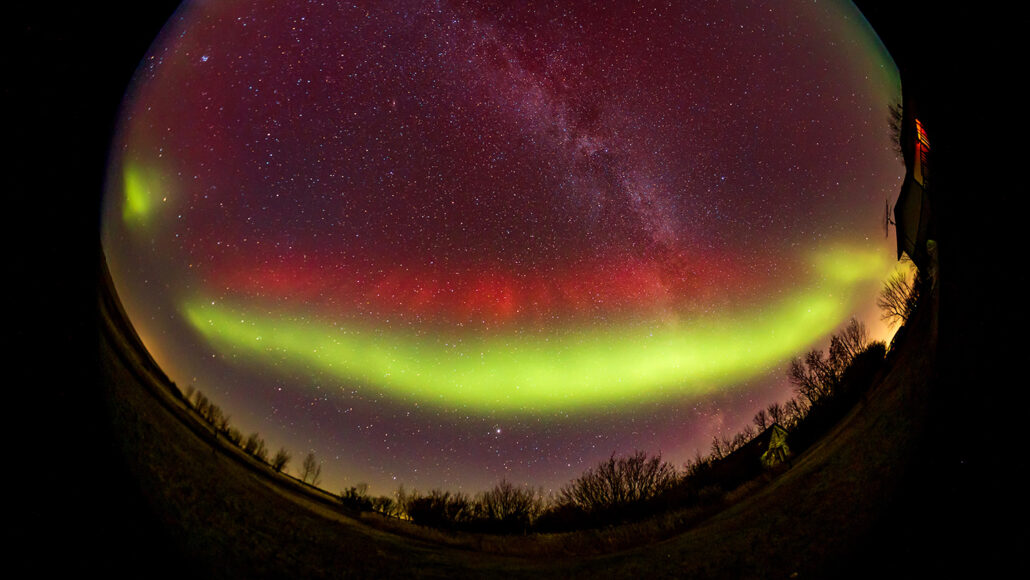amateur: One who engages in a pursuit as a pastime, not as a profession.
astronomy: The area of science that deals with celestial objects, space and the physical universe. People who work in this field are called astronomers.
atmosphere: The envelope of gases surrounding Earth, another planet or a moon.
atom: The basic unit of a chemical element. Atoms are made up of a dense nucleus that contains positively charged protons and uncharged neutrons. The nucleus is orbited by a cloud of negatively charged electrons.
attention: The phenomenon of focusing mental resources on a specific object or event.
aurora: A light display in the sky caused when incoming energetic particles from the sun collide with gas molecules in a planet’s upper atmosphere. The best known of these is Earth’s aurora borealis, or northern lights. On some outer gas planets, like Jupiter and Saturn, the combination of a fast rate of rotation and strong magnetic field leads to high electrical currents in the upper atmosphere, above the planets’ poles. This, too, can cause auroral “light” shows in their upper atmosphere.
citizen scientists: Public volunteers — people of all ages and abilities — who participate in research. The data that these citizen “scientists” collect helps to advance research. Letting the public participate means that science can get data from many more people and places than would be available if they were being collected by trained scientists alone.
electron: A negatively charged particle, usually found orbiting the outer regions of an atom; also, the carrier of electricity within solids.
field: (in physics) A region in space where certain physical effects operate, such as magnetism (created by a magnetic field), gravity (by a gravitational field), mass (by a Higgs field) or electricity (by an electrical field).
footage: (in movies and videos) A term for the uncut or unprocessed motion pictures or video imagery taken by a camera. It takes its name from the fact that it took several feet of film to capture a few seconds of motion-picture photography.
GPS: Abbreviation for global positioning system, which uses a device to calculate the position of individuals or things (in terms of latitude, longitude and elevation — or altitude) from any place on the ground or in the air. The device does this by comparing how long it takes signals from different satellites to reach it.
particle: A minute amount of something.
phenomena: Events or developments that are surprising or unusual.
physics: The scientific study of the nature and properties of matter and energy. A scientist who works in such areas is known as a physicist.
proton: A subatomic particle that is one of the basic building blocks of the atoms that make up matter. Protons belong to the family of particles known as hadrons.
radio: Referring to radio waves, or the device that receives these transmissions. Radio waves are a part of the electromagnetic spectrum that people often use for long-distance communication. Longer than the waves of visible light, radio waves are used to transmit radio and television signals. They also are used in radar. Many astronomical objects also radiate some of their energy as radio waves.
rainbow: An arc of color displayed across the sky during or just after a rain. It’s caused when water droplets in the atmosphere bend (or diffract) white sunlight into a number of its component hues: usually red, orange, yellow, green, blue, indigo and violet.
satellite: A moon orbiting a planet or a vehicle or other manufactured object that orbits some celestial body in space.
solar: Having to do with the sun or the radiation it emits. It comes from sol, Latin for sun.
solar wind: A flow of charged particles (including atomic nuclei) that have been ejected from the surface of the star, such as our sun. It can permeate the solar system. When emitted by a star other than the sun, this radiation is known as a stellar wind.
space weather: Conditions on the sun, in the solar wind and within Earth’s upper atmosphere that can affect technologies on Earth and that have the potential to endanger human health. Triggering these weather events are the stream of plasma, or solar wind, emitted by the sun. In addition, there are clouds of material spewed by the sun, known as coronal mass ejections. Together, these can contribute to large magnetic and electrical storms in Earth’s upper atmosphere.
system: A network of parts that together work to achieve some function. For instance, the blood, vessels and heart are primary components of the human body's circulatory system. Similarly, trains, platforms, tracks, roadway signals and overpasses are among the potential components of a nation's railway system. System can even be applied to the processes or ideas that are part of some method or ordered set of procedures for getting a task done.
unique: Something that is unlike anything else; the only one of its kind.
weather: Conditions in the atmosphere at a localized place and a particular time. It is usually described in terms of particular features, such as air pressure, humidity, moisture, any precipitation (rain, snow or ice), temperature and wind speed. Weather constitutes the actual conditions that occur at any time and place. It’s different from climate, which is a description of the conditions that tend to occur in some general region during a particular month or season.








